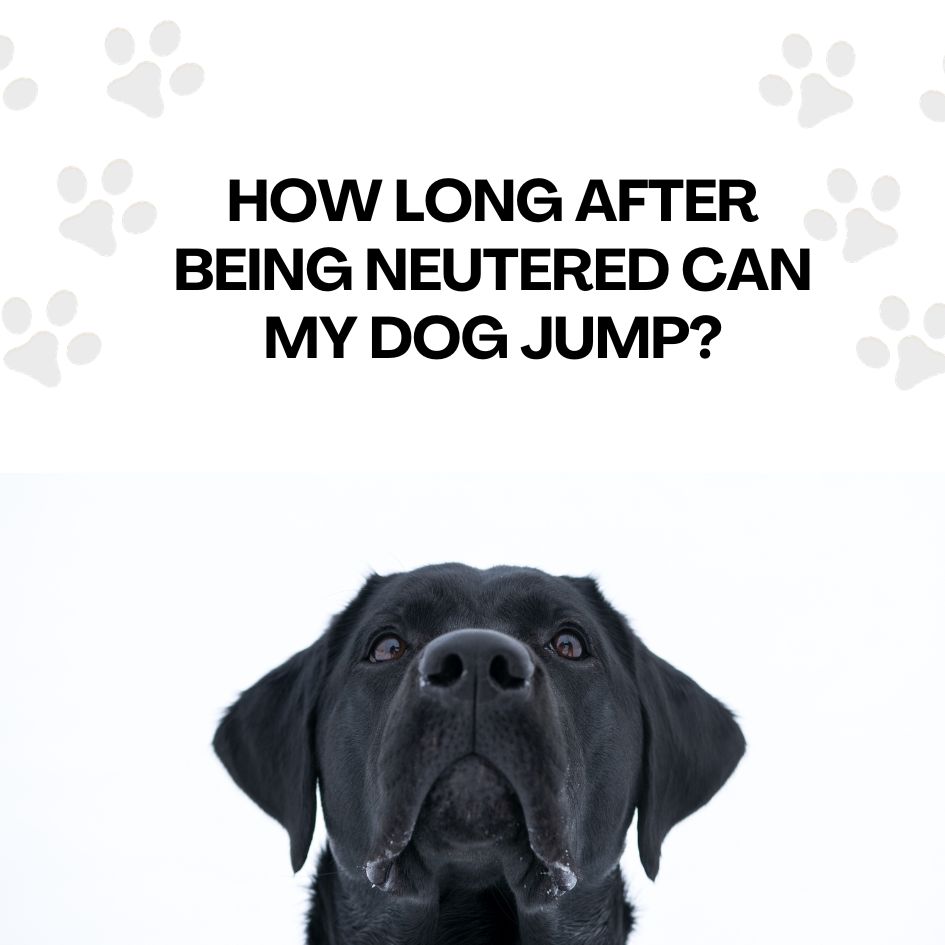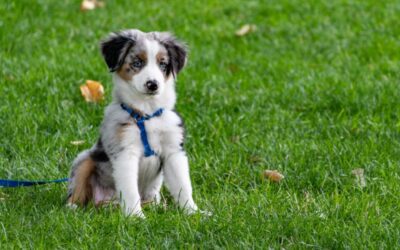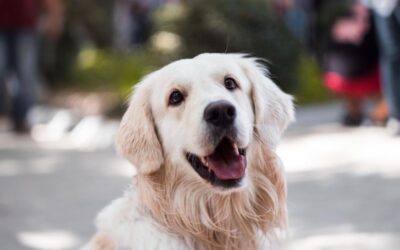Your dog can start jumping again within 1-2 weeks after being neutered. Neutering is a common surgical procedure for dogs that typically has a quick recovery time.
During the initial healing period, it’s important to limit your dog’s activity and prevent them from jumping or exerting themselves too much. However, once the incision has healed and your veterinarian gives the go-ahead, your dog can resume jumping and other physical activities.
It’s always best to consult with your vet to ensure proper healing and minimize any potential complications. By following their advice, you can ensure a smooth and healthy recovery for your furry friend.
The Healing Process After Neutering
Understanding The Immediate Effects Of Neutering On A Dog’s Body
Neutering, also known as castration, is a common surgical procedure performed on dogs to remove their reproductive organs. While it offers many benefits such as preventing unwanted pregnancies and reducing the risk of certain diseases, it is important to understand the immediate effects it has on a dog’s body.
Once the surgery is completed, your dog may experience some immediate effects. It is common for dogs to feel groggy and disoriented due to the anesthesia. Some dogs may also exhibit mild pain or discomfort in the surgical area. It is crucial to follow the post-operative instructions provided by your veterinarian to ensure a smooth recovery.
Exploring The Typical Recovery Period After Neutering
The recovery period after neutering can vary depending on several factors, including the age and overall health of your dog. In general, most dogs start to feel better within a few days after the surgery. However, it is important to note that full recovery can take several weeks.
During the initial phase of recovery, it is essential to provide your dog with a calm and quiet environment. This includes restricting physical activity, preventing jumping, and avoiding strenuous exercise. Your dog may also need to wear an Elizabethan collar to prevent them from licking or biting the surgical incision.
Monitoring the incision site is crucial during the recovery period. Look for any signs of infection, such as redness, swelling, discharge, or excessive pain. If you notice any of these symptoms or have concerns about your dog’s recovery, it is best to consult with your veterinarian for guidance.
Factors That May Affect The Dog’s Healing Process
Various factors can influence the healing process after neutering. One crucial factor is the age of the dog. Younger dogs tend to recover faster than older ones. Additionally, the size and breed of your dog may also play a role in the recovery process.
Other factors that can affect the healing process include the overall health of your dog, the surgical technique used, and the individual dog’s response to surgery. Following proper post-operative care instructions, providing a balanced diet, and avoiding any complications, such as excessive licking or infection, can also contribute to a smooth healing process.
It is important to note that every dog is unique, and recovery times may vary. Some dogs may require a longer recovery period due to individual circumstances. By closely monitoring your dog’s progress and providing them with the necessary care, you can help facilitate a successful healing process.
Exercise Restrictions During The Recovery Period
After your dog has been neutered, it is important to be mindful of their physical activities during the recovery period. Neutering is a routine surgical procedure that is performed to prevent unwanted litters and provide various health benefits for your furry companion. While it may seem tempting to let your dog jump and play as they usually would, it is crucial to follow the exercise restrictions recommended by your veterinarian. By adhering to these restrictions, you can ensure a smooth recovery for your pet and minimize any potential risks associated with jumping too soon after the procedure.
Why It Is Important To Restrict Physical Activities Post-neutering
Restricting physical activities, post-neutering plays a vital role in facilitating the healing process. The surgical incision made during neutering needs time to properly close and heal. Allowing your dog to engage in vigorous activities such as jumping or running excessively can put unnecessary strain on the incision site, increasing the risk of complications, including opening the wound or causing internal bleeding. By providing your dog with a calm and controlled environment, you can assist in their recovery and promote the proper healing of the incision site.
Risks Associated With Jumping Too Soon After The Procedure
Jumping too soon after the neutering procedure can have adverse effects on your dog’s well-being. Dogs have a natural instinct to jump, especially in moments of excitement or to reach for something. However, during the recovery period, their bodies are still adjusting to the changes caused by the surgery. Jumping can strain the muscles, ligaments, and tissues that are trying to heal, leading to delayed recovery, increased pain, and potential complications. It is crucial to prevent your dog from jumping in order to protect their overall health and ensure a successful recovery.
Importance Of Following The Veterinarian’s Recommendations
Your veterinarian is the best source of guidance when it comes to your dog’s post-neutering recovery. They have the expertise and knowledge to assess your pet’s specific condition and provide tailored instructions regarding exercise restrictions. It is essential to follow their recommendations diligently, as they are designed to promote optimal healing and minimize the risk of complications. By taking their advice seriously, you can provide your dog with the best chance of a speedy and uneventful recovery, allowing them to return to their normal activities in a safe and healthy manner.
Timeframe For Resuming Normal Activities
Factors That Determine How Long A Dog Should Wait Before Jumping
After a dog has been neutered, it is essential to allow sufficient time for their bodies to heal before they can resume normal activities, such as jumping. The exact timeframe for each dog may vary based on several factors that can affect their recovery process. Understanding these factors can help dog owners make informed decisions about when it is safe for their furry friends to start jumping again.
One crucial factor to consider is the size and breed of the dog. Larger breeds typically require more time to heal compared to smaller breeds. Additionally, the age of the dog plays a role in determining the recovery time. Younger dogs tend to bounce back quicker than older dogs.
The complexity of the neutering procedure can also influence the recovery timeframe. In some cases, a simple castration may only require a few days of rest, while more invasive surgeries, such as an abdominal neuter, may demand a longer recuperation period.
General Guidelines For Safe Jumping After Neutering
While the specific timeframe may vary depending on individual circumstances, there are some general guidelines that can help dog owners navigate the post-neutering recovery period:
- Restrict physical activity: It is crucial to limit your dog’s physical activity, particularly jumping or any strenuous exercise, for at least 7 to 10 days following the neutering procedure. Rest is essential for proper healing.
- Monitor the incision site: Keep a close eye on your dog’s incision site. Look out for any signs of swelling, redness, discharge, or excessive licking. If you notice any abnormalities, contact your veterinarian immediately.
- Use stairs or ramps: To minimize strain on your dog’s healing body, consider using stairs or ramps instead of allowing them to jump onto or off elevated surfaces. This will help prevent any unnecessary pressure on their surgical area.
- Provide a calm environment: Create a peaceful and calm environment for your dog during their recovery phase. Avoid situations that may cause excitement or excessive movement, as this could hinder the healing process.
- Stick to a controlled diet: Ensure your dog follows a controlled and balanced diet during their recovery. Excessive weight gain or loss can impact their healing process. Consult with your veterinarian for specific dietary recommendations.
The Importance Of Consulting A Veterinarian For A Personalized Timeframe
While these general guidelines offer a starting point, it is crucial to consult with a qualified veterinarian for a personalized timeframe before allowing your dog to resume jumping or any other physical activities. Veterinarians have the expertise and knowledge to assess your dog’s individual condition and provide specific recommendations for their recovery. They will consider factors such as the dog’s overall health, the neutering procedure complexity, and any pre-existing medical conditions that may affect the healing process.
Remember, every dog is unique, and their recovery process may vary. By seeking professional advice, you can ensure that your furry companion’s post-neutering phase is safe and promotes optimal healing.
Monitoring The Dog’s Condition
Monitoring your dog’s condition after neutering is crucial for ensuring a smooth recovery and preventing any potential complications. Keeping a close eye on your furry friend’s progress will help you determine when they are ready to resume their normal activities, including jumping. This article will explore the signs that indicate your dog is ready to jump again, the role of regular check-ups in tracking their progress, and the importance of identifying any potential complications during the recovery period.
Signs That Indicate The Dog Is Ready To Jump Again
After being neutered, it’s natural for your dog to experience some discomfort and soreness. However, as they heal, you may notice certain signs that indicate they are ready to jump again:
- Energetic behavior: Your dog may start showing an increase in energy levels and exhibit their usual playful behavior. This is a positive indication that they are regaining their strength and confidence.
- Painless movements: Watch out for any changes in your dog’s mobility. If they are able to move around without limping or favoring any particular leg, it suggests that their wounds have healed sufficiently.
- Stitch removal: If your dog had stitches, the veterinarian will likely need to remove them after a specific time period. Once the stitches are removed and the incision area looks healed, it is generally a sign that your dog can resume more strenuous activities like jumping.
- Consult with the veterinarian: Always consult with your veterinarian for guidance on when it is safe for your dog to jump again. The veterinarian will consider various factors such as your dog’s breed, age, overall health, and the extent of the surgical procedure to provide you with the most accurate advice.
The Role Of Regular Check-ups In Tracking The Dog’s Progress
Regular check-ups with your veterinarian play a vital role in monitoring your dog’s recovery progress after being neutered. These appointments allow the veterinarian to assess the healing process and address any concerns or complications that may arise. Here’s why regular check-ups are crucial:
- Wound evaluation: During check-ups, the veterinarian will carefully examine the surgical incision site, ensuring it is healing well with no signs of infection. They will also check for any swelling, redness, or discharge, which could indicate a developing complication.
- Pain management: Veterinarians can assess your dog’s level of pain and adjust the medication accordingly. Proper pain management is vital for ensuring your dog’s comfort during the recovery period.
- Progress assessment: Regular check-ups provide an opportunity to evaluate your dog’s overall progress. The veterinarian can determine if your dog is healing at the expected rate and make any necessary recommendations for their continued recovery.
Identifying Any Potential Complications Or Issues During The Recovery Period
Even with proper care, complications can occur during the recovery period after neutering. Regular check-ups are essential for identifying any potential issues early on, allowing timely intervention. Here are some complications to watch out for:
- Infection: Excessive redness, swelling, discharge, or a foul odor around the incision site may indicate an infection. Prompt treatment is necessary to prevent further complications.
- Excessive licking or biting: If your dog excessively licks or bites at the incision area, it can delay healing and increase the risk of infection.
- Delayed healing: If the incision site doesn’t seem to be healing or there are any prolonged signs of discomfort, it is crucial to have it checked by a veterinarian.
- Behavioral changes: Any sudden changes in behavior, such as lethargy, loss of appetite, or aggression, could be indicative of a problem. These signs should be reported to the veterinarian during a check-up.
Gradual Increase In Activity Levels
Gradual Increase in Activity Levels
After your dog has been neutered, it is important to allow sufficient time for their body to heal and recover. The recovery period varies depending on the individual dog and the surgical technique used. In general, it is recommended to wait at least 2 weeks before gradually increasing the activity level, including jumping and other high-impact activities.
Tips For Gradually Reintroducing Jumping And Other High-impact Activities
- Start with short, low-impact jumps: Begin by encouraging your dog to jump over small obstacles like low hurdles or ground-level jumps. This allows them to regain their strength and coordination without putting too much strain on their healing body.
- Monitor for signs of discomfort: During the reintroduction process, closely observe your dog for any signs of pain or discomfort. If you notice limping, stiffness, or reluctance to jump, it may be an indication that they are not yet ready for more activity. Consult with your veterinarian if you have concerns.
- Gradually increase the height and intensity of jumps: As your dog becomes more comfortable and shows no signs of discomfort, you can gradually raise the height of the jumps. It is important to do this incrementally to prevent any setbacks in their recovery. Slowly introduce higher hurdles or obstacles, ensuring that your dog is able to clear them with ease.
Incorporating Mental And Physical Stimulation During The Recovery Process
While your dog is recovering from the neutering surgery, it is essential to provide them with mental and physical stimulation to keep their minds engaged and their bodies active in a controlled manner. This helps prevent boredom, promotes healing, and aids in a smooth transition back to full activity levels.
Here are some suggestions:
- Interactive puzzle toys: These toys can help stimulate your dog’s mental abilities and keep them occupied without requiring excessive physical exertion. Look for puzzles that challenge their problem-solving skills and provide rewards for successfully completing the tasks.
- Gentle obedience training: Engage your dog in gentle obedience training sessions that focus on commands that do not involve excessive physical activity. This keeps their minds active and strengthens your bond with them.
- Nose work games: Dogs have a highly developed sense of smell, and engaging them in nose work games can provide mental stimulation while encouraging them to use their natural abilities. Hide treats or toys around the house or in the yard, and let your dog use their nose to locate them.
Balancing Exercise And Rest For A Smooth Transition
During the recovery process, it is crucial to strike a balance between exercise and rest. Too much activity can impede the healing process, while too little can lead to muscle weakness and stiffness.
| Exercise Recommendations | Rest Recommendations |
|---|---|
| Take short, controlled walks on leash | Provide a comfortable and quiet resting area |
| Engage in supervised play sessions indoors | Avoid activities that require excessive jumping or running |
| Use mentally stimulating toys and activities | Allow your dog plenty of downtime to relax and recover |
By carefully balancing exercise and rest, you can help ensure a smooth transition for your dog and minimize the risk of complications during the recovery stage.
Frequently Asked Questions Of How Long After Being Neutered Can My Dog Jump
How Long Does It Take For A Dog To Recover After Being Neutered?
Recovery time after neutering varies, but most dogs are back to normal within 10 to 14 days. It’s important to follow post-operative care instructions to ensure a smooth recovery.
Can My Dog Jump After Being Neutered?
After being neutered, it’s best to limit your dog’s jumping and strenuous activity for at least 2 weeks. Jumping too soon can strain the incision site and delay healing.
When Can My Dog Resume Normal Activities After Being Neutered?
Your dog can gradually resume normal activities, including jumping, after 2 weeks following the neutering procedure. Monitor their behavior and consult your veterinarian if you have any concerns.
Conclusion
It’s important to give your dog the proper time to heal after being neutered before allowing them to jump. Generally, it is recommended to wait at least 7-10 days for the incision to heal and any swelling to reduce. This helps prevent any complications that could arise from excessive strain on the surgical site.
Always consult with your veterinarian for specific guidance and listen to your dog’s individual needs during the recovery period. Taking the proper precautions ensures your furry friend can safely resume their active lifestyle.




